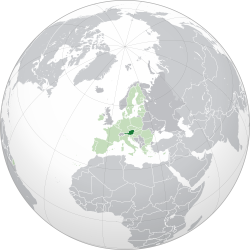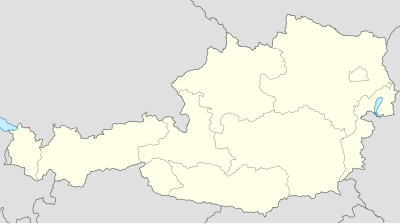
A | B | C | D | E | F | G | H | CH | I | J | K | L | M | N | O | P | Q | R | S | T | U | V | W | X | Y | Z | 0 | 1 | 2 | 3 | 4 | 5 | 6 | 7 | 8 | 9
Republic of Austria Republik Österreich (German) | |
|---|---|
| Anthem: "Bundeshymne der Republik Österreich" "National Anthem of the Republic of Austria" | |
Location of Austria (dark green) – in Europe (green & dark grey) | |
| Capital and largest city | Vienna 48°12′N 16°21′E / 48.200°N 16.350°E |
| Official languages | German[a][b] |
| Official regional languages | |
| Ethnic groups (2020)[3] | |
| Religion (2021)[4] |
|
| Demonym(s) | Austrian |
| Government | Federal semi-presidential republic[5][c] |
| Alexander Van der Bellen | |
| Karl Nehammer | |
| Legislature | Parliament |
| Federal Council | |
| National Council | |
| Formation | |
• Name | 1 November 996 |
• Duchy | 17 September 1156 |
| 6 January 1453 | |
• Empire | 11 August 1804 |
| 30 March 1867 | |
| 12 November 1918 | |
| 10 September 1919 | |
| 1 May 1934 | |
| 13 March 1938 | |
| 27 April 1945 | |
| 27 July 1955 | |
• Joined the European Union | 1 January 1995 |
| Area | |
• Total | 83,879[6] km2 (32,386 sq mi) (113th) |
• Water (%) | 0.84 (2015)[7] |
| Population | |
• April 2022 estimate | |
• Density | 107.6/km2 (278.7/sq mi) (106th) |
| GDP (PPP) | 2024 estimate |
• Total | |
• Per capita | |
| GDP (nominal) | 2024 estimate |
• Total | |
• Per capita | |
| Gini (2021) | low |
| HDI (2022) | very high (22nd) |
| Currency | Euro (€) (EUR) |
| Time zone | UTC+1 (CET) |
• Summer (DST) | UTC+2 (CEST) |
| Date format | dd/mm/yyyy |
| Driving side | right |
| Calling code | +43 |
| ISO 3166 code | AT |
| Internet TLD | .at |
Austria,[d] formally the Republic of Austria,[e] is a landlocked country in Central Europe, lying in the Eastern Alps.[13] It is a federation of nine federal states, one of which is the capital, Vienna, the most populous city and federal state. Austria is bordered by Germany to the northwest, the Czech Republic to the north, Slovakia to the northeast, Hungary to the east, Slovenia and Italy to the south, and Switzerland and Liechtenstein to the west. The country occupies an area of 83,879 km2 (32,386 sq mi) and has a population of around 9 million.[14]
The area of today's Austria had been inhabited since at least the Paleolithic period. Around 400 BC, it was inhabited by the Celts and then annexed by the Romans in the late 1st century BC. Christianization in the region began in the 4th and 5th centuries, during the late Roman period, followed by the arrival of numerous Germanic tribes during the Migration Period.[15] Austria, as a unified state, emerged from the remnants of the Eastern and Hungarian March at the end of the first millennium, first as a frontier march of the Holy Roman Empire, it then developed into a duchy in 1156, and was made an Archduchy in 1453. Being the heartland of the Habsburg monarchy since the late 13th century, Austria was a major imperial power in Central Europe for centuries and from the 16th century, Vienna was also serving as the Holy Roman Empire's administrative capital.[16] Before the dissolution of the empire two years later, in 1804, Austria established its own empire, which became a great power and one of the largest states in Europe during its whole existence. The empire's defeat in wars and the loss of territories in the 1860s paved the way for the establishment of Austria-Hungary in 1867.[17]
After the assassination of Archduke Franz Ferdinand in 1914, Emperor Franz Joseph declared war on Serbia, which ultimately escalated into World War I. The empire's defeat and subsequent collapse led to the proclamation of the Republic of German-Austria in 1918 and the First Austrian Republic in 1919. During the interwar period, anti-parliamentarian sentiments culminated in the formation of an Austrofascist dictatorship under Engelbert Dollfuss in 1934. A year before the outbreak of World War II, Austria was annexed into Nazi Germany by Adolf Hitler, and it became a sub-national division. After its liberation in 1945 and a decade of Allied occupation, the country regained its sovereignty and declared its perpetual neutrality in 1955.
Austria is a semi-presidential[c] representative democracy with a popularly elected president as head of state and a chancellor as head of government and chief executive. Major cities include Vienna, Graz, Linz, Salzburg, and Innsbruck. Austria has the 13th highest nominal GDP per capita with high standards of living; it was ranked 22th in the world for its Human Development Index in 2022. The country has been a member of the United Nations since 1955[18] and of the European Union since 1995.[19] It hosts the Organization for Security and Co-operation in Europe (OSCE) and the Organization of the Petroleum Exporting Countries (OPEC) and is a founding member of the Organisation for Economic Co-operation and Development (OECD) and Interpol.[20] It also signed the Schengen Agreement in 1995,[21] and adopted the euro currency in 1999.[22]
Etymology
The native name for Austria, Österreich, derives from the Old High German Ostarrîchi, which meant "eastern realm" and which first appeared in the "Ostarrîchi document" of 996.[23][24] This word is probably a translation of Medieval Latin Marchia orientalis into a local (Bavarian) dialect.
Austria was a prefecture of Bavaria created in 976. The word "Austria" is a Latinisation of the German name and was first recorded in the 12th century.[25] At the time, the Danube basin of Austria (Upper and Lower Austria) was the easternmost extent of Bavaria.
History
Antiquity

The area that is now Austria was settled in pre-Roman times by various Celtic tribes, having been the core of the Hallstatt culture by the 6th century BC.[26] The city of Hallstatt, in fact, has the oldest archaeological evidence of the Celts in Europe.[27]
The Celtic Kingdom of Noricum that included most of modern Austria and parts of modern Slovenia was conquered by the Roman Empire in 16 BC and made a province called Noricum which lasted until the year of 476.[28] The regions of today's Austria which were not located within the province of Noricum were divided between the Roman provinces of Pannonia, which encompassed parts of eastern Austria, and Raetia, which encompassed the areas of today Vorarlberg and Tyrol.[29][30]
Present-day Petronell-Carnuntum in eastern Austria was an important army camp turned capital city in what became known as the Pannonia Superior. Carnuntum was home for 50,000 people for nearly 400 years.[31]
Middle Ages
After the fall of the Roman Empire, the area was first invaded by the Germanic Rugii which made this region part of their "Rugiland".[32] In 487, most of modern Austria was conquered by Odoacer, a barbarian soldier and statesman from the Middle Danube, which incorporated most of today's Austria in his Kingdom of Italy. By 493, it was conquered by the Germanic Ostrogoths which created their own kingdom, the Ostrogothic Kingdom.[33] Following the Kingdom's fall the area was invaded by the Alemanni, Baiuvarii, Slavs, and Avars.[34][35]
Charlemagne, King of the Franks, conquered the area in 788, encouraged colonisation, and introduced Christianity.[34] As part of Eastern Francia, the core areas that now encompass Austria were bequeathed to the house of Babenberg. The area was known as the marchia Orientalis and was given to Leopold of Babenberg in 976.[36]
The first record showing the name Austria is from 996, where it is written as Ostarrîchi, referring to the territory of the Babenberg March.[36] In 1156, the Privilegium Minus elevated Austria to the status of a duchy. In 1192, the Babenbergs also acquired the Duchy of Styria. With the death of Frederick II in 1246, the line of the Babenbergs was extinguished.[37]
As a result, Ottokar II of Bohemia effectively assumed control of the duchies of Austria, Styria, and Carinthia.[37] His reign came to an end with his defeat at Dürnkrut at the hands of Rudolph I of Germany in 1278.[38] Thereafter, until World War I, Austria's history was largely that of its ruling dynasty, the Habsburgs.
In the 14th and 15th centuries, the Habsburgs began to accumulate other provinces in the vicinity of the Duchy of Austria. In 1438, Duke Albert V of Austria was chosen as the successor to his father-in-law, Emperor Sigismund. Although Albert himself only reigned for a year, henceforth every emperor of the Holy Roman Empire was a Habsburg, with only one exception.
The Habsburgs began also to accumulate territory far from the hereditary lands. In 1477, Archduke Maximilian, only son of Emperor Frederick III, married the heiress Maria of Burgundy, thus acquiring most of the Netherlands for the family.[39][40] In 1496, his son Philip the Fair married Joanna the Mad, the heiress of Castile and Aragon, thus acquiring Spain and its Italian, African, Asian, and New World appendages for the Habsburgs.[39][40]
In 1526, following the Battle of Mohács, Bohemia and the part of Hungary not occupied by the Ottomans came under Austrian rule.[41] Ottoman expansion into Hungary led to frequent conflicts between the two empires, particularly evident in the Long War of 1593 to 1606. The Turks made incursions into Styria nearly 20 times,[42] of which some are cited as "burning, pillaging, and taking thousands of slaves".[43] In late September 1529, Suleiman the Magnificent launched the first siege of Vienna, which unsuccessfully ended, according to Ottoman historians, with the snowfalls of an early beginning winter.
17th and 18th centuries

During the long reign of Leopold I, Holy Roman Emperor following the successful defence of Vienna against the Turks in 1683, under the command of the King of Poland John III Sobieski,[44] the Great Turkish War resulted in most of Hungary being controlled by Austria. This arrangement was formalized in the Treaty of Karlowitz in 1699.
Emperor Charles VI, Holy Roman Emperor relinquished many of the gains the empire made in the previous years. He enjoyed the imminent extinction of the House of Habsburg. Charles VI was willing to offer concrete advantages in territory and authority in exchange for recognition of the Pragmatic Sanction of 1713. Therefore, his daughter Maria Theresa was recognized as his heir. With the rise of Prussia, the Austria–Prussia rivalry began in Germany. Austria participated, together with Prussia and Russia, in the first and the third of the three Partitions of Poland in 1772 and 1795 respectively.
From that time, Austria became the birthplace of classical music and played host to different composers including Joseph Haydn, Wolfgang Amadeus Mozart, Ludwig van Beethoven, and Franz Schubert.
19th century
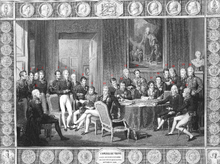
Austria later became engaged in a war with Revolutionary France, which was highly unsuccessful in the beginning, with successive defeats at the hands of Napoleon Bonaparte, meaning the end of the old Holy Roman Empire in 1806. Two years earlier,[45] the Empire of Austria was founded. From 1792 to 1801, the Austrians had suffered 754,700 casualties.[46] In 1814, Austria was part of the Allied forces that invaded France and brought to an end the Napoleonic Wars.
It emerged from the Congress of Vienna in 1815 as one of the continent's four dominant powers and a recognised great power. The same year, the German Confederation (Deutscher Bund) was founded under the presidency of Austria. Because of unsolved social, political, and national conflicts, the German lands were shaken by the 1848 revolutions aiming to create a unified Germany.[47]
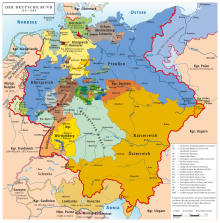
The various different possibilities for a united Germany were: a Greater Germany, or a Greater Austria or just the German Confederation without Austria at all. As Austria was not willing to relinquish its German-speaking territories to what would become the German Empire of 1848, the crown of the newly formed empire was offered to the Prussian King Friedrich Wilhelm IV. In 1864, Austria and Prussia fought together against Denmark and secured the independence from Denmark of the duchies of Schleswig and Holstein. As they could not agree on how the two duchies should be administered, though, they fought the Austro-Prussian War in 1866. Defeated by Prussia in the Battle of Königgrätz,[47] Austria had to leave the German Confederation and no longer took part in German politics.[48][49]
After the defeated Hungarian Revolution of 1848, the Austro-Hungarian Compromise of 1867, the Ausgleich, provided for a dual sovereignty, the Austrian Empire and the Kingdom of Hungary, under Franz Joseph I.[50] The Austrian-Hungarian rule of this diverse empire included various groups, including Germans, Hungarians, Croats, Czechs, Poles, Rusyns, Serbs, Slovaks, Slovenes, and Ukrainians, as well as large Italian and Romanian communities.
As a result, ruling Austria-Hungary became increasingly difficult in an age of emerging nationalist movements, requiring considerable reliance on an expanded secret police. Yet, the government of Austria tried its best to be accommodating in some respects: for example, the Reichsgesetzblatt, publishing the laws and ordinances of Cisleithania, was issued in eight languages; and all national groups were entitled to schools in their own language and to the use of their mother tongue at state offices.

Many Austrians of all different social circles such as Georg Ritter von Schönerer promoted strong pan-Germanism in hope of reinforcing an ethnic German identity and the annexation of Austria to Germany.[51] Some Austrians such as Karl Lueger also used pan-Germanism as a form of populism to further their own political goals. Although Bismarck's policies excluded Austria and the German Austrians from Germany, many Austrian pan-Germans idolised him and wore blue cornflowers, known to be the favourite flower of German Emperor William I, in their buttonholes, along with cockades in the German national colours (black, red, and yellow), although they were both temporarily banned in Austrian schools, as a way to show discontent towards the multi-ethnic empire.[52]
Austria's exclusion from Germany caused many Austrians a problem with their national identity and prompted the Social Democratic Leader Otto Bauer to state that it was "the conflict between our Austrian and German character".[53] The Austro-Hungarian Empire caused ethnic tension between the German Austrians and the other ethnic groups. Many Austrians, especially those involved with the pan-German movements, desired a reinforcement of an ethnic German identity and hoped that the empire would collapse, which would allow an annexation of Austria by Germany.[54]
A lot of Austrian pan-German nationalists protested passionately against minister-president Kasimir Count Badeni's language decree of 1897, which made German and Czech co-official languages in Bohemia and required new government officials to be fluent in both languages. This meant in practice that the civil service would almost exclusively hire Czechs, because most middle-class Czechs spoke German but not the other way around. The support of ultramontane Catholic politicians and clergy for this reform triggered the launch of the Away from Rome movement, which was initiated by supporters of Schönerer and called on "German" Christians to leave the Roman Catholic Church.[55]
Early 20th century
As the Second Constitutional Era began in the Ottoman Empire, Austria-Hungary took the opportunity to annex Bosnia and Herzegovina in 1908.[56] The assassination of Archduke Franz Ferdinand in Sarajevo in 1914 by Bosnian Serb Gavrilo Princip[57] was used by leading Austrian politicians and generals to persuade the emperor to declare war on Serbia, thereby risking and prompting the outbreak of World War I, which eventually led to the dissolution of the Austro-Hungarian Empire. Over one million Austro-Hungarian soldiers died in World War I.[58]

On 21 October 1918 the elected German members of the Reichsrat (parliament of Imperial Austria) met in Vienna as the Provisional National Assembly for German Austria (Provisorische Nationalversammlung für Deutschösterreich). On 30 October the assembly founded the Republic of German-Austria by appointing a government, called Staatsrat. This new government was invited by the Emperor to take part in the decision on the planned armistice with Italy, but refrained from this business.[59]
This left the responsibility for the end of the war, on 3 November 1918, solely to the emperor and his government. On 11 November, the emperor, advised by ministers of the old and the new governments, declared he would not take part in state business any more; on 12 November, German-Austria, by law, declared itself to be a democratic republic and part of the new German republic. The constitution, renaming the Staatsrat as Bundesregierung (federal government) and Nationalversammlung as Nationalrat (national council) was passed on 10 November 1920.[60]
The Treaty of Saint-Germain of 1919 (for Hungary the Treaty of Trianon of 1920) confirmed and consolidated the new order of Central Europe which to a great extent had been established in November 1918, creating new states and altering others. The German-speaking parts of Austria which had been part of Austria-Hungary were reduced to a rump state named the Republic of German-Austria (German: Republik Deutschösterreich), though excluding the predominantly German-speaking South Tyrol.[61][62][63] The desire for the annexation of Austria to Germany was a popular opinion shared by all social circles in both Austria and Germany.[64] On 12 November, German-Austria was declared a republic, and named Social Democrat Karl Renner as provisional chancellor. On the same day it drafted a provisional constitution that stated that "German-Austria is a democratic republic" (Article 1) and "German-Austria is an integral part of the German reich" (Article 2).[65] The Treaty of Saint Germain and the Treaty of Versailles explicitly forbade union between Austria and Germany.[66][67] The treaties also forced German-Austria to rename itself as "Republic of Austria" which consequently led to the first Austrian Republic.[68][69]
Over three million German-speaking Austrians found themselves living outside the new Austrian Republic as minorities in the newly formed or enlarged states of Czechoslovakia, Yugoslavia, Hungary, and Italy.[70] These included the provinces of South Tyrol, and German Bohemia. The status of German Bohemia and Sudetenland later played a role in World War II.[71]
The border between Austria and the Kingdom of Yugoslavia was settled with the Carinthian Plebiscite in October 1920 and allocated the major part of the territory of the former Austro-Hungarian Crownland of Carinthia to Austria. This set the border on the Karavanke mountain range, with many Slovenes remaining in Austria.
Interwar period and World War II
After the war, inflation began to devalue the Krone, which was still Austria's currency. In autumn 1922, Austria was granted an international loan supervised by the League of Nations.[72] The purpose of the loan was to avert bankruptcy, stabilise the currency, and improve Austria's general economic condition. The loan meant that Austria passed from an independent state to the control exercised by the League of Nations. In 1925, the Austrian schilling was introduced, replacing the Krone at a rate of 10,000:1. Later, it was nicknamed the "Alpine dollar" due to its stability. From 1925 to 1929 the economy enjoyed a short high before nearly crashing after Black Tuesday.
The First Austrian Republic lasted until 1933, when Chancellor Engelbert Dollfuss, using what he called "self-switch-off of Parliament", established an autocratic regime tending towards Italian fascism.[73][74] The two big parties at this time, the Social Democrats and the Conservatives, had paramilitary armies;[75] the Social Democrats' Republikanischer Schutzbund was now declared illegal, but was still operative[75] as the 12–15 February 1934 Austrian Civil War broke out.[73][74][76]
In February 1934, several members of the Schutzbund were executed,[77] the Social Democratic party was outlawed, and many of its members were imprisoned or emigrated.[76] On 1 May 1934, the Austrofascists imposed a new constitution ("Maiverfassung") which cemented Dollfuss's power, but on 25 July he was assassinated in an Austrian Nazi coup attempt.[78][79]

His successor Kurt Schuschnigg acknowledged the fact that Austria was a "German state" and he also believed that Austrians were "better Germans" but he wished that Austria would remain independent.[80] He announced a referendum on 9 March 1938, to be held on 13 March, concerning Austria's independence from Germany.
Nazi rule
On 12 March 1938, Austrian Nazis took over the government, while German troops occupied the country, which prevented Schuschnigg's referendum from taking place.[81] On 13 March 1938, the Anschluss (lit. 'joining' or 'connection') of Austria was officially declared. Two days later, Austrian-born Adolf Hitler announced what he called the "reunification" of his home country with the "rest of the German Reich" on Vienna's Heldenplatz. He established a referendum which confirmed the union with Germany in April 1938.
Parliamentary elections were held in Germany (including recently annexed Austria) on 10 April 1938. They were the final elections to the Reichstag during Nazi rule, and they took the form of a single-question referendum asking whether voters approved of a single Nazi-party list for the 813-member Reichstag, as well as the recent annexation of Austria (the Anschluss). Jews, Roma and Sinti were not allowed to vote.[82] Turnout in the election was officially 99.5%, with 98.9% voting "yes". In the case of Austria, Adolf Hitler's native soil, 99.71% of an electorate of 4,484,475 officially went to the ballots, with a positive tally of 99.73 percent.[83] Although most Austrians favored the Anschluss, in certain parts of Austria, the German soldiers were not always welcomed with flowers and joy, especially in Vienna, which had Austria's largest Jewish population.[84] Nevertheless, despite the propaganda and the manipulation and rigging which surrounded the ballot box result, there was massive genuine support for Hitler for fulfilling the Anschluss,[85] since many Germans from both Austria and Germany saw it as completing the long overdue unification of all Germans into one state.[86]
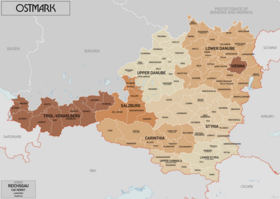
On 13 March 1938, Austria was annexed by the Third Reich and ceased to exist as an independent country (the Anschluss). The Aryanisation of the wealth of Jewish Austrians started immediately in mid-March, with a so-called "wild" (i.e. extra-legal) phase, but it was soon structured legally and bureaucratically so the assets which Jewish citizens possessed could be stripped from them. At that time, Adolf Eichmann, who grew up in Austria, was transferred to Vienna and ordered to persecute the Jews. During the November pogrom in 1938 ("Reichskristallnacht"), Jews and Jewish institutions such as synagogues were subjected to violent attacks in Vienna, Klagenfurt, Linz, Graz, Salzburg, Innsbruck and several cities in Lower Austria.[87][88][89][90][91] Otto von Habsburg, a vehement opponent of the Nazis, the last Crown Prince of Austria-Hungary, an honorary citizen of hundreds of places in Austria and partly envisaged by Schuschnigg as a monarchical option, was in Belgium at the time. He spoke out against the Anschluss and was then wanted by the Nazi regime and his property would have been expropriated and he would have been shot immediately if he were caught.[92] In 1938, the Nazis renamed Austria the "Ostmark",[81] a name which it had until 1942, when it was renamed the "Alpine and Danubian Gaue" (Alpen-und Donau-Reichsgaue).[93][94]
Though Austrians made up only 8% of the population of the Third Reich,[95] some of the most prominent Nazis were native Austrians, including Adolf Hitler, Ernst Kaltenbrunner, Arthur Seyss-Inquart, Franz Stangl, Alois Brunner, Friedrich Rainer, and Odilo Globocnik,[96] as were over 13% of the members of the SS and 40% of the staff at the Nazi extermination camps.[95] In the Reichsgau, besides the main camp KZ-Mauthausen, there were numerous sub-camps in all provinces where Jews and other prisoners were killed, tortured and exploited.[97] At this time, because the territory was outside the operational radius of Allied aircraft, the armaments industry was greatly expanded through the forced labor of concentration camp prisoners, this was especially the case with regard to the manufacture of fighter planes, tanks and missiles.[98][99][100]
Most of the resistance groups were soon crushed by the Gestapo. While the plans of the group around Karl Burian to blow up the Gestapo's headquarters in Vienna were uncovered,[101] the important group around the later executed priest Heinrich Maier managed to contact the Allies. This so-called Maier-Messner group was able to send the Allies information about armaments factories where V-1 flying bombs, V-2 rockets, Tiger tanks, and aircraft (Messerschmitt Bf 109, Messerschmitt Me 163 Komet, etc.) were manufactured, information which was important to the success of Operation Crossbow and Operation Hydra, both of which were preliminary missions before the launch of Operation Overlord. This resistance group, which was in contact with the American secret service (OSS), soon provided information about mass executions and concentration camps such as Auschwitz. The group's aim was to cause Nazi Germany to lose the war as quickly as possible and re-establish an independent Austria.[102][103][104]
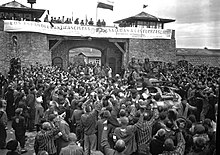
Allied occupation
Vienna fell on 13 April 1945, during the Soviet Vienna offensive, just before the total collapse of the Third Reich. The invading Allied powers, in particular the Americans, planned for the supposed "Alpine Fortress Operation" of a national redoubt, that was largely to have taken place on Austrian soil in the mountains of the Eastern Alps. However, it never materialised because of the rapid collapse of the Reich.
Karl Renner and Adolf Schärf (Socialist Party of Austria ), Leopold Kunschak (Austria's People's Party ), and Johann Koplenig (Communist Party of Austria) declared Austria's secession from the Third Reich by the Declaration of Independence on 27 April 1945 and set up a provisional government in Vienna under state Chancellor Renner the same day, with the approval of the victorious Red Army and backed by Joseph Stalin.[105] (The date is officially named the birthday of the second republic.) At the end of April, most of western and southern Austria were still under Nazi rule. On 1 May 1945, the Federal Constitutional Law of 1920, which had been terminated by dictator Dollfuss on 1 May 1934, was declared valid again. The total number of Austrian military deaths from 1939 to 1945 was 260,000.[106] The total number of Jewish Austrian Holocaust victims was 65,000.[107] About 140,000 Jewish Austrians had fled from the country in 1938–39. Thousands of Austrians had taken part in serious Nazi crimes (hundreds of thousands of people died in the Mauthausen-Gusen concentration camp alone), a fact which was officially acknowledged by Chancellor Franz Vranitzky in 1992.
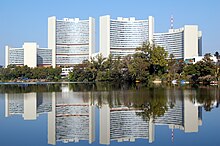
Allied-occupied Austria was after World War II divided into military occupation zones. Austria was governed by the Allied Commission for Austria.[108] As stipulated in the Moscow Declaration of 1943 a subtle difference was seen in the treatment of Austria by the Allies.[105]
The Austrian government, consisting of Social Democrats, Conservatives, and Communists resided in Vienna, which was surrounded by the Soviet zone. This Austrian government was recognised by the allies of World War II in October 1945 despite concerns that Karl Renner could be Stalin's puppet.[109] On 26 July 1946 the Austrian Parliament passed its first nationalization law and approximately 70 mining and manufacturing companies were seized by the Austrian state. The Ministry of Property Protection and Economic Planning (Ministerium für Vermögenssicherung und Wirtschaftsplanung) was responsible for directing the nationalized industries under the directorship of Minister Peter Krauland (party ÖVP).[110]
Independence
On 15 May 1955, after talks which lasted for years and were influenced by the Cold War Austria regained full independence by concluding the Austrian State Treaty with the allies of World War II. On 26 October 1955 all occupation troops had left and Austria declared its permanent neutrality by an act of parliament.[111] This day is now Austria's National Day, a public holiday.[112]
The status of Tyrol is a lingering problem between Austria and Italy. To this day, there are 20 different squares in Austrian cities called "Südtiroler Platz" (South Tyrolean Square) in memory of the supposed loss of the Austrian territories. Riots by the South Tyrolean independence movement have been documented in the 1950s and 1960s. A great degree of autonomy was granted to Tyrol by the Italian national government.

The political system of the Second Republic is based on the constitution of 1920 and 1929, which was reintroduced in 1945. The system came to be characterised by Proporz, whereby most posts of political importance were split proportionately between members of the Social Democratic Party of Austria (SPÖ) and the Austrian People's Party (ÖVP).[113] Interest group "chambers" with mandatory membership (e.g. for workers, business people, farmers) grew to considerable importance and were usually consulted in the legislative process, so hardly any legislation was passed that did not reflect widespread consensus.[114]
Since 1945, governing via a single-party government has occurred twice: 1966–1970 (ÖVP) and 1970-1983 (SPÖ). During all other legislative periods, either a grand coalition of SPÖ and ÖVP or a "small coalition" (one of these two and a smaller party) ruled the country.
Kurt Waldheim, the former secretary-general of the United Nations, was elected President of Austria from 1986 to 1992. He had been a Wehrmacht officer in the Second World War and was accused of war crimes.[115]
Following a referendum in 1994, at which consent reached a majority of two-thirds, the country became a member of the European Union on 1 January 1995.[116]
The major parties SPÖ and ÖVP have contrary opinions about the future status of Austria's military nonalignment: While the SPÖ in public supports a neutral role, the ÖVP argues for stronger integration into the EU's security policy; even a future NATO membership is not ruled out by some ÖVP politicians (ex. Werner Fasslabend (ÖVP) in 1997).[citation needed] In reality, Austria is taking part in the EU's Common Foreign and Security Policy, participates in peacekeeping and peace creating tasks, and has become a member of NATO's "Partnership for Peace"; the constitution has been amended accordingly.[117] Since Liechtenstein joined the Schengen Area in 2011, none of Austria's neighbouring countries performs border controls towards it anymore.[118]
Government and politics
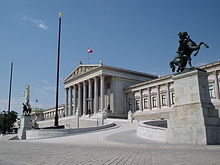
The Parliament of Austria is located in Vienna, the country's capital and most populous city. Austria became a federal, representative democratic republic through the Federal Constitutional Law of 1920. The political system of the Second Republic with its nine federal states is based on the constitution of 1920, amended in 1929, which was re-enacted on 1 May 1945.[119]
The president of Austria is the head of state. The president is directly elected by popular majority vote, with a run-off between the top-scoring candidates if necessary. The chancellor of Austria is head of the government. The chancellor is selected by the president and tasked with forming a government based on the partisan composition of the lower house of parliament.
The government can be removed from office by either a presidential decree or by vote of no confidence in the lower chamber of parliament, the Nationalrat. Voting for the president and for the parliament used to be compulsory in Austria. The compulsion was abolished in steps from 1982 to 2004.[120]
Austria's parliament consists of two chambers. The composition of the Nationalrat (183 seats) is determined every five years (or whenever the Nationalrat has been dissolved by the federal president on a motion by the federal chancellor, or by Nationalrat itself) by a general election in which every citizen over the age of 16 has the right to vote. The voting age was lowered from 18 in 2007.[121]
While there is a general threshold of 4% of the vote for all parties in federal elections (Nationalratswahlen) to participate in the proportional allocation of seats, there remains the possibility of being elected to a seat directly in one of the 43 regional electoral districts (Direktmandat).
The Nationalrat is the dominant chamber in the legislative process in Austria. However, the upper house of parliament, the Bundesrat, has a limited right of veto (the Nationalrat can—in almost all cases—ultimately pass the respective bill by voting a second time; this is referred to as a Beharrungsbeschluss, lit. "vote of persistence"). A constitutional convention, called the Österreich -Konvent[122] was convened on 30 June 2003 to consider reforms to the constitution, but failed to produce a proposal that would command a two-thirds majority in the Nationalrat, the margin necessary for constitutional amendments or reform.
While the bicameral Parliament and the Government constitute the legislative and executive branches, respectively, the courts are the third branch of Austrian state powers. The Constitutional Court (Verfassungsgerichtshof) exerts considerable influence on the political system because of its power to invalidate legislation and ordinances that are not in compliance with the constitution. Since 1995, the European Court of Justice may overrule Austrian decisions in all matters defined in laws of the European Union. Austria also implements the decisions of the European Court of Human Rights, since the European Convention on Human Rights is part of the Austrian constitution.
Since 2006

After general elections held in October 2006, the Social Democratic Party (SPÖ) emerged as the strongest party, and the Austrian People's Party (ÖVP) came in second, having lost about 8% of its previous polling.[123][124] Political realities prohibited any of the two major parties from forming a coalition with smaller parties. In January 2007 the People's Party and SPÖ formed a grand coalition with the social democrat Alfred Gusenbauer as Chancellor. This coalition broke up in June 2008.
Elections in September 2008 further weakened both major parties (SPÖ and ÖVP) but together they still held 70% of the votes, with the Social Democrats holding slightly more than the other party. They formed a coalition with Werner Faymann from the Social Democrats as Chancellor. The Green Party came in third with 11% of the vote. The FPÖ and the deceased Jörg Haider's new party Alliance for the Future of Austria, both on the political right, were strengthened during the election but taken together received less than 20% of the vote. On 11 October 2008, Jörg Haider died in a car accident.[125]
In the legislative elections of 2013, the Social Democratic Party received 27% of the vote and 52 seats; People's Party 24% and 47 seats, thus controlling together the majority of the seats. The Freedom Party received 40 seats and 21% of the votes, while the Greens received 12% and 24 seats. Two new parties, Stronach and the NEOS, received less than 10% of the vote, and 11 and nine seats respectively.[126]
On 17 May 2016, Christian Kern from Social Democrats (SPÖ) was sworn in as new chancellor. He continued governing in a "grand coalition" with the conservative People's Party (ÖVP). He took the office after former chancellor, also from SPÖ, Werner Faymann's resignation.[127]
On 26 January 2017, Alexander Van der Bellen was sworn in as the mostly ceremonial – but symbolically significant – role of Austrian president.[128]
After the Grand Coalition broke in Spring 2017 a snap election was proclaimed for October 2017. The Austrian People's Party (ÖVP) with its new young leader Sebastian Kurz emerged as the largest party in the National Council, winning 31.5% of votes and 62 of the 183 seats. The Social Democratic Party (SPÖ) finished second with 52 seats and 26.9% votes, slightly ahead of the Freedom Party of Austria (FPÖ), which received 51 seats and 26 percent. NEOS finished fourth with 10 seats (5.3% of votes), and PILZ (which split from the Green Party at the start of the campaign) entered parliament for the first time and came in fifth place with 8 seats and 4.4% The Green Party failed with 3.8% to cross the 4% threshold and was ejected from parliament, losing all of its 24 seats.[129] The ÖVP decided to form a coalition with the FPÖ. The new government between the centre-right wing and the right-wing populist party under the new chancellor Sebastian Kurz was sworn in on 18 December 2017,[130] but the coalition government later collapsed in the wake of the "Ibiza" corruption scandal[131] and new elections were called for 29 September 2019. The elections lead to another landslide victory (37.5 percent) of the Austrian People's Party (ÖVP) who formed a coalition-government with the reinvigorated (13.9 percent) Greens, which was sworn in with Kurz as chancellor on 7 January 2020.[132]
On 11 October 2021, Chancellor Sebastian Kurz resigned, after pressure triggered by a corruption scandal. Foreign Minister Alexander Schallenberg of ÖVP succeeded him as chancellor.[133] Following a corruption scandal involving the ruling People's Party, Austria got its third conservative chancellor in two months after Karl Nehammer was sworn into office on 6 December 2021. His predecessor Alexander Schallenberg had left the office after less than two months. ÖVP and the Greens continued to govern together.[134]
A year after Karl Nehammer was sworn into office, Austria disagreed to Bulgaria's and Romania's accession to the Schengen Area.[135] In the two countries, the Austrian veto caused a considerable outrage. Because of the controversial vote, Romania withdrew its ambassador from Vienna.[136] Citizens of Romania were advised by the government not to travel to Austria for skiing, and a boycott against Austrian companies like OMV and Raiffeisen is still ongoing.[137]
Foreign relations

The 1955 Austrian State Treaty ended the occupation of Austria following World War II and recognised Austria as an independent and sovereign state. On 26 October 1955, the Federal Assembly passed a constitutional article in which "Austria declares of her own free will her perpetual neutrality." The second section of this law stated that "in all future times Austria will not join any military alliances and will not permit the establishment of any foreign military bases on her territory." Since then, Austria has shaped its foreign policy on the basis of neutrality, but rather different from the neutrality of Switzerland.
Austria began to reassess its definition of neutrality following the fall of the Soviet Union, granting overflight rights for the UN-sanctioned action against Iraq in 1991, and since 1995, it has developed participation in the EU's Common Foreign and Security Policy. Also in 1995, it joined NATO's Partnership for Peace (although it was careful to do so only after Russia joined) and subsequently participated in peacekeeping missions in Bosnia. Meanwhile, the only part of the Constitutional Law on Neutrality of 1955 still fully valid is not to allow foreign military bases in Austria.[138] Austria signed the UN's Nuclear Weapon Ban Treaty,[139] which was opposed by all NATO members.[140]
Austria attaches great importance to participation in the Organisation for Economic Co-operation and Development and other international economic organisations, and it has played an active role in the Organization for Security and Cooperation in Europe (OSCE). As an OSCE-participating state, Austria's international commitments are subject to monitoring under the mandate of the U.S. Helsinki Commission.
Military

The manpower of the Austrian Armed Forces (Austrian German: Bundesheer) mainly relies on conscription.[141] All males who have reached the age of eighteen and are found fit have to serve a six months compulsory military service, followed by an eight-year reserve obligation. Both males and females at the age of sixteen are eligible for voluntary service.[19] Conscientious objection is legally acceptable and those who claim this right are obliged to serve an institutionalised nine months civilian service instead. Since 1998, women volunteers have been allowed to become professional soldiers.
The main sectors of the Bundesheer are Joint Forces (Streitkräfteführungskommando, SKFüKdo) which consist of Land Forces (Landstreitkräfte), Air Forces (Luftstreitkräfte), International Missions (Internationale Einsätze) and Special Forces (Spezialeinsatzkräfte), next to Joint Mission Support Command (Kommando Einsatzunterstützung; KdoEU) and Joint Command Support Centre (Führungsunterstützungszentrum; FüUZ). Austria is a landlocked country and has no navy.
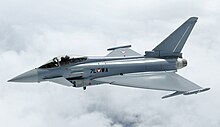
In 2012, Austria's defence expenditures corresponded to approximately 0.8% of its GDP. The Army currently has about 26,000[142] soldiers, of whom about 12,000 are conscripts. As head of state, the Austrian president is nominally the commander-in-chief of the Armed Forces. Command of the Austrian Armed Forces is exercised by the minister of defence, as of May 2020[update]: Klaudia Tanner.
Since the end of the Cold War, and more importantly the removal of the former heavily guarded "Iron Curtain" separating Austria and its Eastern Bloc neighbours (Hungary and former Czechoslovakia), the Austrian military has been assisting Austrian border guards in trying to prevent border crossings by illegal immigrants. This assistance came to an end when Hungary and Slovakia joined the EU Schengen Area in 2008, for all intents and purposes abolishing "internal" border controls between treaty states. Some politicians have called for a prolongation of this mission, but the legality of this is heavily disputed. In accordance with the Austrian constitution, armed forces may only be deployed in a limited number of cases, mainly to defend the country and aid in cases of national emergency, such as in the wake of natural disasters.[143] They may only exceptionally be used as auxiliary police forces.
Within its self-declared status of permanent neutrality, Austria has a tradition of engaging in UN-led peacekeeping and other humanitarian missions. The Austrian Forces Disaster Relief Unit (AFDRU), in particular, an all-volunteer unit with close ties to civilian specialists (e.g. rescue dog handlers) enjoys a reputation as a quick (standard deployment time is 10 hours) and efficient SAR unit. Currently, larger contingents of Austrian forces are deployed in Bosnia and Kosovo.[citation needed]
Administrative divisions
Austria is a federal republic consisting of nine federal states (Austrian German: Bundesländer).[19] The federal states are sub-divided into districts (Bezirke) and statutory cities (Statutarstädte). Districts are subdivided into municipalities (Gemeinden). Statutory Cities have the competencies otherwise granted to both districts and municipalities. Vienna is unique in that it is both a city and a federal state. The European Commission's Directorate-General for Translation calls the federal states provinces.
| Federal state | Capital | Area (sq km) |
Population (1 Jan 2017) |
Density per km2 |
GDP (billion euros) (2012 Eurostat) |
GDP per capita |
|---|---|---|---|---|---|---|
| Eisenstadt | 3,965 | 291,942 | 73.6 | 7.311 | 25,600 | |
| Klagenfurt | 9,536 | 561,077 | 58.8 | 17.62 | 31,700 | |
| Sankt Pölten | 19,178 | 1,665,753 | 86.9 | 49.75 | 30,800 | |
| Salzburg | 7,154 | 549,263 | 76.8 | 23.585 | 44,500 | |
| Graz | 16,401 | 1,237,298 | 75.4 | 40.696 | 33,600 | |
| Innsbruck | 12,648 | 746,153 | 59.0 | 28.052 | 39,400 | |
| Linz | 11,982 | 1,465,045 | 122.3 | 53.863 | 38,000 | |
| 415 | 1,867,582 | 4,500 | 81.772 | 47,300 | ||
| Bregenz | 2,601 | 388,752 | 149.5 | 14.463 | 38,900 | |
| [144][145] | ||||||
Geography
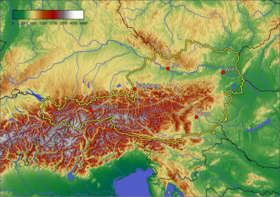

Austria is a largely mountainous country because of its location in the Alps.[146] The Central Eastern Alps, Northern Limestone Alps, and Southern Limestone Alps are all partly in Austria. Of the total area of Austria (83,871 km2 or 32,383 sq mi), only about a quarter can be considered low lying, and only 32% of the country is below 500 metres (1,640 ft). The Alps of western Austria give way somewhat into low lands and plains in the eastern part of the country.
Austria lies between latitudes 46° and 49° N, and longitudes 9° and 18° E.
It can be divided into five areas, the biggest being the Eastern Alps, which constitute 62% of the nation's total area. The Austrian foothills at the base of the Alps and the Carpathians account for around 12% and the foothills in the east and areas surrounding the periphery of the Pannoni low country amount to about 12% of the total landmass. The second greater mountain area (much lower than the Alps) is situated in the north. Known as the Austrian granite plateau, it is located in the central area of the Bohemian Mass and accounts for 10% of Austria. The Austrian portion of the Vienna basin makes up the remaining 4%.[147]
Phytogeographically, Austria belongs to the Central European province of the Circumboreal Region within the Boreal Kingdom. According to the WWF, the territory of Austria can be subdivided into four ecoregions: the Central European mixed forests, Pannonian mixed forests, Alps conifer and mixed forests, and Western European broadleaf forests.[148] Austria had a 2018 Forest Landscape Integrity Index mean score of 3.55/10, ranking it 149th globally out of 172 countries.[149]
Climate

The greater part of Austria lies in the cool/temperate climate zone, where humid westerly winds predominate. With nearly three-quarters of the country dominated by the Alps, the alpine climate is predominant. In the east—in the Pannonian Plain and along the Danube valley—the climate shows continental features with less rain than the alpine areas. Although Austria is cold in the winter (−10 to 0 °C), summer temperatures can be relatively high,[151] with average temperatures in the mid-20s and a highest temperature of 40.5 °C (105 °F) in August 2013.[152]
According to the Köppen Climate Classification Austria has the following climate types: Oceanic (Cfb), Cool/Warm-summer humid continental (Dfb), Subarctic/Subalpine (Dfc), Tundra/Alpine (ET), and Ice-Cap (EF). It is important to note though that Austria may experience very cold, severe winters, but most of the time they are only around as cold as those in somewhat comparable climate zones, for example Southern Scandinavia or Eastern Europe. As well, at higher altitudes, summers are usually considerably cooler than in the valleys/lower altitudes. The subarctic and tundra climates seen around the Alps are much warmer in winter than what is normal elsewhere due in part to the Oceanic influence on this part of Europe.[152][153][154]
Economy

Austria consistently ranks high in terms of GDP per capita,[155] due to its highly industrialised economy, and well-developed social market economy. Until the 1980s, many of Austria's largest industry firms were nationalised; in recent years, however, privatisation has reduced state holdings to a level comparable to other European economies. Labour movements are particularly influential, exercising large influence on labour politics and decisions related to the expansion of the economy. Next to a highly developed industry, international tourism is the most important part of the economy of Austria.
Germany has historically been the main trading partner of Austria, making it vulnerable to rapid changes in the German economy. Since Austria became a member state of the European Union, it has gained closer ties to other EU economies. Membership of the EU has drawn an influx of foreign investors attracted by Austria's access to the single European market and proximity to the aspiring economies of the European Union. Growth in GDP reached 3.3% in 2006.[156] At least 67% of Austria's imports come from other European Union member states.[157]
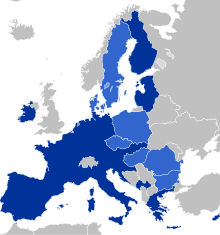
The Financial crisis of 2007–2008 dented the economy of Austria in other ways as well. It caused, for example, the Hypo Alpe-Adria-Bank International to be purchased in December 2009 by the government for 1 euro owing to credit difficulties, thus wiping out the €1.63bn of BayernLB. As of February 2014[update], the HGAA situation was unresolved,[158] causing Chancellor Werner Faymann to warn that its failure would be comparable to the 1931 Creditanstalt event.[159]
Austria indicated on 16 November 2010 that it would withhold the December installment of its contribution to the EU bailout of Greece, citing the material worsening of the Greek debt situation and the apparent inability of Greece to collect the level of tax receipts it had previously promised.[160]
Since the fall of communism, Austrian companies have been quite active players and consolidators in Eastern Europe. Between 1995 and 2010, 4,868 mergers and acquisitions with a total known value of 163 billion EUR with the involvement of Austrian firms have been announced.[161] The largest transactions with involvement of Austrian companies[162] have been: the acquisition of Bank Austria by HypoVereinsbank for 7.8 billion EUR in 2000, the acquisition of Porsche Holding Salzburg by Volkswagen Group for 3.6 billion EUR in 2009,[163] and the acquisition of Banca Comercială Română by Erste Group for 3.7 billion EUR in 2005.[164]
Tourism in Austria accounts for almost 9% of its gross domestic product.[165] In 2007, Austria ranked 9th worldwide in international tourism receipts, with 18.9 billion US$.[166] In international tourist arrivals, Austria ranked 12th with 20.8 million tourists.[166]
Infrastructure and natural resources
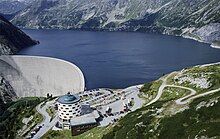
In 1972 the country began construction of a nuclear power plant to produce electricity at Zwentendorf on the River Danube, following a unanimous vote in parliament. However, in 1978 a referendum voted approximately 50.5% against nuclear power, 49.5% for,[167] and parliament subsequently unanimously passed a law forbidding the use of nuclear power to generate electricity although the nuclear power plant had already finished.
Austria currently produces more than half of its electricity by hydropower.[168] Together with other renewable energy sources such as wind power, solar power, and biomass, the electricity supply from renewable energy amounts to 62.89 percent.[169]
Compared to most European countries, Austria is ecologically well endowed. Its biocapacity (or biological natural capital) is more than double of the world average: In 2016 Austria had 3.8 global hectares[170] of biocapacity per person within its territory, compared to the world average of 1.6 global hectares per person. By contrast, in 2016 they used 6.0 global hectares of biocapacity which amounts to Austria's ecological footprint of consumption. This means that Austrians use about 60% more biocapacity than Austria contains. As a result, Austria is running a biocapacity deficit.[170]
Demographics
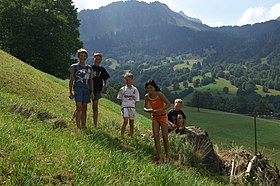
Austria's population was estimated to be nearly 9 million (8.9) in 2020 by Statistik Austria.[171] The population of the capital, Vienna, exceeds 1.9 million[172] (2.6 million, including the suburbs), representing about a quarter of the country's population. It is known for its cultural offerings and high standard of living.
Vienna is by far the country's largest city. Graz is second in size, with 291,007 inhabitants, followed by Linz (206,604), Salzburg (155,031), Innsbruck (131,989), and Klagenfurt (101,303). All other cities have fewer than 100,000 inhabitants.
According to Eurostat, in 2018 there were 1.69 million foreign-born residents in Austria, corresponding to 19.2% of the total population; 928,700 (10.5%) were born outside the EU and 762,000 (8.6%) were born in another EU member state.[173] There are more than 483,100 descendants of foreign-born immigrants.[174]
Turks form one of the largest ethnic groups in Austria, numbering around 350,000.[175] 13,000 Turks were naturalised in 2003 and an unknown number have arrived in Austria at the same time. While 2,000 Turks left Austria in the same year, 10,000 immigrated to the country, confirming a strong trend of growth.[176] Together, Serbs, Croats, Bosniaks, Macedonians, and Slovenes make up about 5.1% of Austria's total population. The Council of Europe estimates that approximately 25,000 Romani people live in Austria.[177]
The total fertility rate (TFR) in 2017 was estimated at 1.52 children born per woman,[178] below the replacement rate of 2.1, it remains considerably below the high of 4.83 children born per woman in 1873.[179] In 2015, 42.1% of births were to unmarried women.[180] Austria had the 14th oldest population in the world in 2020, with the average age of 44.5 years.[181] The life expectancy in 2016 was estimated at 81.5 years (78.9 years male, 84.3 years female).[182]
Statistics Austria estimates that the population will grow to 10.55 million people by 2080 due to immigration.[183]



